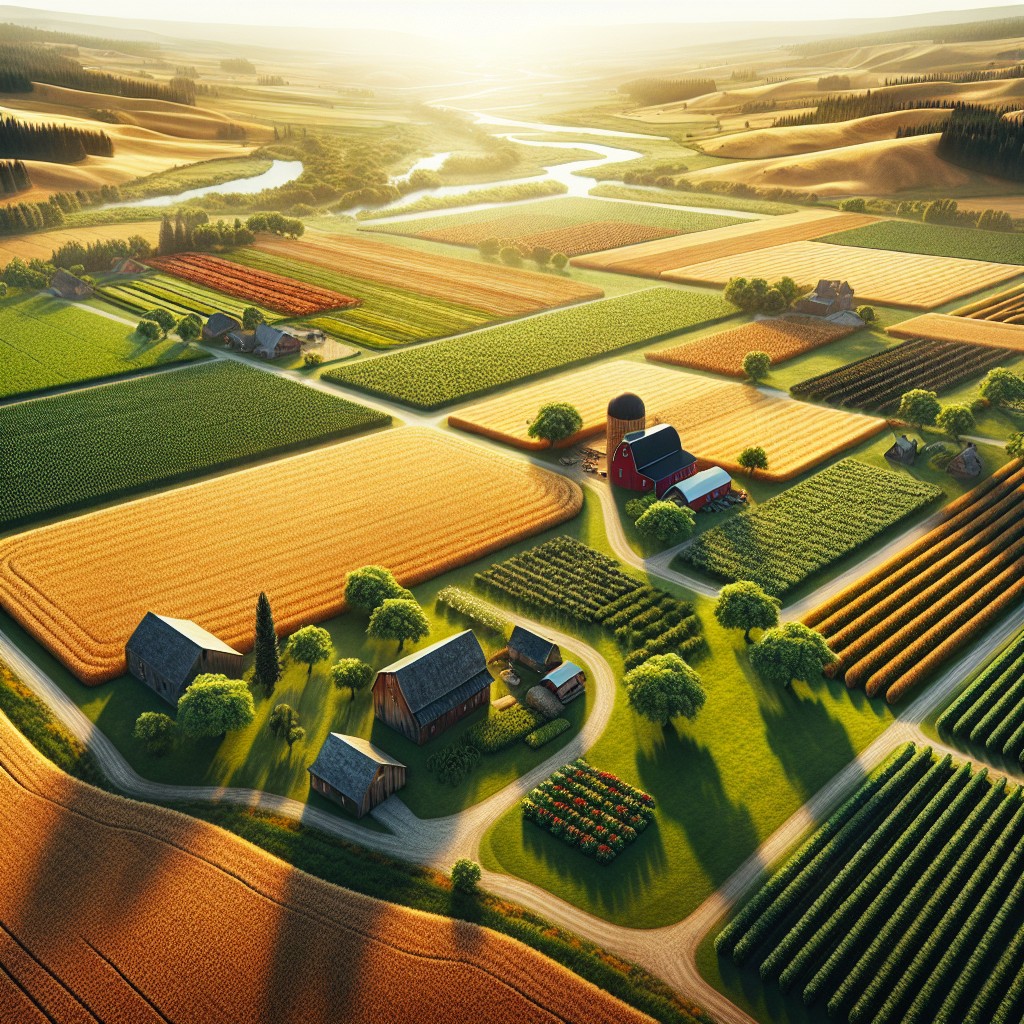Last updated on
Get ready to comprehend the vastness of 500 acres as we delve into a comprehensive comparison with familiar landmarks, objects, and environments.
Key takeaways:
- A football field is about 1.32 acres, so 500 acres is approximately 380 football fields.
- 500 acres is equivalent to over 72,000 parking spaces or a large shopping mall’s parking lot.
- To circle 500 acres, you’d need to run around a standard high school football track over 30 times.
- 500 acres is roughly 60% of the size of Central Park in New York City.
- Disney World covers nearly 25,000 acres, making 500 acres approximately 2% of the entire resort’s size.
What's Inside
Visualizing 500 Acres: Size Comparison to Common Objects

Picturing a space as vast as 500 acres might feel like a daunting task. To put it into perspective, consider common objects as a reference.
- A football field, including the end zones, is about 1.32 acres. Imagine lining up roughly 380 of these fields side by side, and you’ll have measured out an area close to 500 acres.
- Parking spaces are another everyday reference point. An average parking space is about 300 square feet. It would take over 72,000 parking spaces to cover the same expanse, akin to an enormous shopping mall’s parking lot.
- If you’re familiar with the standard track around a high school football field, it’s typically a quarter of a mile in length. To circle 500 acres, you’d need to run around that track well over 30 times.
These examples serve as a starting point to grasp the sheer size of 500 acres, grounding the concept into tangible, visual chunks.
Understanding Acreage: Definition and Measurement Units

An acre is a unit of land measurement historically derived from the area that a yoke of oxen could plough in a day, now standardized to 43,560 square feet. To put this into a global context, consider that one acre is roughly equivalent to:
- about 4,047 square meters
- roughly 0.405 hectares
- almost the size of an American football field, excluding end zones
In terms of residential lots, an average city lot is typically between 1/8th and 1/4th of an acre. So, 500 acres would be the equivalent of 4,000 to 2,000 average city lots. This comparison helps illustrate the scale of 500 acres in a suburban or urban setting.
When dealing with large land measurements, larger units such as square miles can be more convenient. There are 640 acres in a square mile, meaning 500 acres is slightly less than one square mile (approximately 0.78 square miles or 2.02 square kilometers). Understanding these conversions and comparisons can significantly aid in grasping the true size of 500 acres.
Acres: Football Fields Comparison
Picture this: the standard American football field, including the end zones, measures about 1.32 acres. By this comparison, 500 acres is roughly equivalent to 380 football fields laid side by side. This gives you a vast expanse of turf, more than enough for every NFL team to play simultaneously with room to spare! It highlights not only the sheer size of 500 acres but also presents a familiar visual for a concept that might otherwise be hard to grasp.
If you’ve ever been in a stadium, imagine the green beneath you multiplied almost four hundred times – that’s the space we’re talking about. It’s enough to host a series of major sports tournaments all at once, a testament to just how large an area 500 acres really is. This analogy connects something intangible, like acreage, with a concrete and familiar image, making it much easier to relate to and understand.
Acres: Relation to Central Park in New York City
Central Park, an urban sanctuary for New Yorkers, spans approximately 843 acres. To put 500 acres into perspective with this famous park, imagine roughly 60% of its expanse. That’s more than half of Central Park’s sprawling lawns, placid waters, and winding pathways.
Here are some points that might help you visualize the size comparison:
- Picture about six out of the ten smaller lakes in Central Park fitting snugly into a 500-acre space.
- Think of the Great Lawn, a 55-acre green space, and multiply that nearly nine times.
- The popular Reservoir covers 106 acres; 500 acres would be akin to almost five Reservoirs.
- If you’ve strolled around the 1.58-mile running track lining the Reservoir, three and a half laps would be the perimeter of a 500-acre plot.
- The Metropolitan Museum of Art, occupying 11 acres, could theoretically be repositioned 45 times within a 500-acre area.
Using Central Park as a reference, we can appreciate the vastness of 500 acres in an urban context, revealing a vast canvas of potential in what this space might accommodate.
Agricultural Perspective: Farm Sizes Compared to 500 Acres
When considered within the context of agriculture, 500 acres can provide substantial farming space. Across the United States, the average size of a farm is about 444 acres, according to the USDA. This means 500 acres slightly surpasses the national average, granting enough land for diverse farming operations, ranging from large-scale crop production to livestock grazing.
To offer a tangible example, if each acre was used to grow wheat, you could expect to harvest approximately 30,000 to 60,000 bushels based on average yields. That’s enough to bake around 4.5 to 9 million loaves of bread. In the world of livestock, 500 acres could comfortably support a cattle operation of roughly 100 head, considering the standard of 2 to 5 acres per cow-calf pair for grazing.
It’s important to note the variable nature of farming means these figures can swing widely. Factors such as soil quality, climate, farming practices, and the type of crops or animals being raised all impact what can realistically be done with 500 acres of agricultural land.
Acres Vs. Disney World: Theme Park Size Comparison
When comparing 500 acres to the size of Disney World, it’s clear that this vast land area can hold its own even against the grandiosity of the Happiest Place on Earth. Disney World covers nearly 25,000 acres, making 500 acres a substantial yet smaller portion, roughly 2% of the entire resort’s footprint.
To put it in perspective:
- The Magic Kingdom, the iconic park famously known for Cinderella’s Castle, spans about 107 acres. This means 500 acres could contain almost five Magic Kingdoms.
- Epcot, another Disney World theme park, occupies roughly 300 acres. Thus, 500 acres is significantly larger than Epcot alone, underscoring the scale at which land is utilized for entertainment and recreation.
- A 500-acre area could serve as a blueprint for a complete theme park, with ample space for attractions, amenities, parking, and even expansion. It’s a testament to the significant amount of planning required to develop entertainment venues of this magnitude.
- Beyond the rides and attractions, Disney World dedicates a considerable portion of its land to natural conservation. This highlights how 500 acres could also contribute to preserving biodiversity and creating green spaces within urban landscapes.
By understanding the sheer scale of Disney’s massive theme park complex, it becomes easier to appreciate the magnitude of 500 acres and its potential as a versatile canvas for a variety of large-scale projects or attractions.
Real Estate Development On 500 Acres
Embarking upon a real estate development project on a scale of 500 acres is an endeavor that requires meticulous planning and understanding of spatial needs. To put it into perspective:
- Mixed-Use Developments: Think of a small town layout including residential areas, shopping centers, offices, parks, and sports facilities—all harmoniously designed within this expanse.
- Residential Neighborhoods: This vast area could comfortably accommodate over 2,000 average-sized homes with ample backyard space, community amenities, and public services.
- Commercial Complexes: If dedicated to commercial use, envision a sprawling shopping mall with parking lots, landscaped areas, and potentially even space for an accompanying hotel or convention center.
- Green Spaces: Integrating green areas is essential. With 500 acres, developers can incorporate parks, trails, or golf courses, enhancing the liveability and appeal of the development.
- Infrastructure and Roads: Key to development are the arterial routes and infrastructure—enough to support a small city’s worth of traffic and utilities.
Remember, infrastructure isn’t just about buildings and roads; water supply, sewage, and power grids are part of this groundwork. The potential of such a space, when thoughtfully developed, is immense and can springboard a region into economic prosperity.
Forestation: Trees That Can Fit in 500 Acres
Envisioning 500 acres of land can feel abstract until you consider the potential for forestation. This expanse can accommodate a substantial number of trees, which play a pivotal role in ecological balance and carbon sequestration.
On average, you could plant about 1,000 trees per acre if each tree had an area of about 435 square feet to grow, a spacing typical for a managed forest.
This means that half a thousand acres could support approximately 500,000 trees. However, that number can swing dramatically depending on the species and the forest management objectives. For example, if the trees are planted for timber, they might be spaced wider to allow for growth of larger canopies and trunks, thus reducing the total count. Conversely, reforestation projects, aiming for higher density, could increase the count per acre.
Also, certain fast-growing species like pines and poplars can thrive closer together, while majestic oaks and redwoods need more space. Tree planting schemes might also incorporate biodiversity considerations, introducing a mix of species that provide for different wildlife habitats, potentially altering the quantity a 500-acre area can sustain.
The sheer scope of 500 acres opens up diverse possibilities for forestation, ranging from dense, commercially productive plantations to mixed-use forests that support both wildlife and sustainable lumber. Understanding these dynamics reveals the massive potential for land conservation and resource management within such a substantial area.
Accessibility: Walking and Driving Across 500 Acres
Consider the sheer scope of a 500-acre parcel; it’s an immense space to traverse. On foot, covering this distance could become a hearty workout, much like embarking on a mini-hike. Let’s assume the average walking speed is about 3 miles per hour. Covering the length of 500 acres, depending on its layout, could easily be a several-hour journey.
Now, switch modes of transport to driving. In a vehicle, averaging a speed of 30 miles per hour, you’d zip through the expanse in mere minutes, a testament to human engineering’s impact on mobility. The layout, once again, dictates the drive time—if roads are straight, it’s a quick trip; windy or unpaved paths naturally slow things down.
Despite the mode of transport, one point is clear: 500 acres provides a generous canvas for endless activities, whether leisurely strolls or off-road adventures. It’s the freedom to roam or the perfect plot for the ambitious planner—space that promises potential and demands respect.
Planning and Zoning: Managing 500 Acres of Land
When tackling the colossal task of planning and zoning 500 acres, we dive into a realm where meticulous urban and rural planning come into play.
1. Zoning Laws & Regulations: First things first, zoning ordinances dictate how the land can be used—residential, commercial, industrial, or agricultural—and set parameters regarding building heights, densities, and placement.
2. Master Planning: Think of a master plan as a roadmap for future growth and development. It involves laying out infrastructure like roads, utilities, and public spaces, ensuring that the development suits both current and future needs.
3. Environmental Considerations: Responsible management means accounting for ecological impacts. This includes protecting natural resources, conserving wildlife habitats, and implementing green spaces to promote biodiversity.
4. Community Input: Engaging with the community gives a voice to those who will be affected by the development. Public meetings and forums are essential for gathering input and building consensus.
5. Economic Strategy: A viable development incorporates economic strategies that cater to job creation, support local economies, and consider market demands.
6. Infrastructure Development: Adequate planning for water, sewage, power, and internet is a cornerstone of functionality, particularly over such an expansive area.
7. Transportation Networks: How will people get around? Planning must consider road networks, potential public transit systems, and pedestrian pathways.
8. Sustainable Practices: Emphasizing renewable energy, sustainable building materials, and waste reduction methods future-proofs the development.
Managing 500 acres is an intricate process that balances the aspirations of human development with the mandate to maintain ecological and social integrity.
FAQ
How big is an acre visually?
Visually, an acre is roughly equivalent to about 90% of a football field.
How many football fields is 5 acres?
Five acres is approximately equivalent to four standard American football fields in size.
How long is the perimeter of 500 acres?
The perimeter of 500 acres is approximately 139.14 yards, 834.8413 feet, or 253.8456 meters.
How long is 1 acre?
An acre is conventionally defined as 66 feet by 660 feet, approximately equivalent to a square of 208.71 feet by 208.71 feet.
How many square miles are in 500 acres?
The area of 500 acres is approximately 0.78125 square miles.
What is the comparison of 500 acres to the size of Central Park in New York?
Central Park in New York City measures 843 acres, which is 1.686 times larger than 500 acres.
How many times can the Vatican City fit into 500 acres?
The Vatican City, measuring about 108 acres, can fit into 500 acres approximately 4.63 times.




